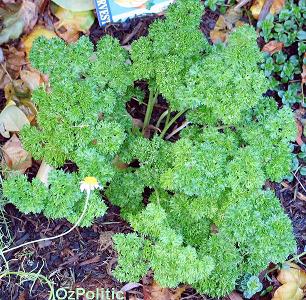|
Parsley
Previous
Next
Up
Home

Parsley is slow growing, but it lives for a long time and will keep producing. I use it in dips, pesto and as a garnish on pasta, as well as an ingredient in pasta sauce. It does well in shade. Your primary concern in planting parsley is to choose a spot that you can keep moist and which you are prepared to weed regularly, as there aren't many plants that grow slower. I have only once had a parsley plant go to seed, so I collected them for future plantings. I have parsley growing at three different locations around the house.
If you have brushtail possums then you must keep it covered. They will discover it eventually and will keep coming back until they have eaten it all down to the ground, which kills it after about the third occasion. Scrub turkeys also seem to like it. Depending on it's location, a sturdy cover may not be necessary. I usually just place a ring of 30cm wide chicken mesh around it. It doesn't need the same level of protection that tomato plants do.
Parsley (Petroselinum crispum) is a bright green, biennial herb and used also as spice that is very common in Middle Eastern, European, and American cooking. It is used for its leaf in much the same way as coriander (which is also known as Chinese parsley or cilantro), although it has a milder flavour.
Two forms of parsley are used as herbs: curly leaf and Italian or flat leaf (P. neapolitanum). Curly leaf parsley is often used as a garnish. Many people think flat leaf parsley has a stronger flavour, and this opinion is backed by chemical analysis which finds much higher levels of essential oil in the flat-leaved cultivars. One of the compounds of the essential oil is apiol. Another type of parsley is grown as a root vegetable.
The use of curly leaf parsley is often favoured, because it can not be confused with poison hemlock like flat leaf parsley or chervil.
Parsley is used as a food plant by the larvae of some Lepidoptera species including the Mouse Moth and The Nutmeg.
In parts of Europe, and particularly in West Asia, many foods are served with chopped parsley sprinkled on top. The fresh flavour of parsley goes extremely well with fish. Parsley is essential to several West Asian salads, e.g., tabbouleh which is the national dish of Lebanon. In Southern and Central Europe, parsley is part of bouquet garni, a bundle of fresh herbs used to flavour stocks, soups and sauces. Additionally, parsley is often used as a garnish. Persillade is mixture of chopped garlic and chopped parsley. Gremolata is a mixture of parsley, garlic, and lemon zest.
Parsley is valued as a breath-freshener, due to its high concentration of chlorophyll. Adam Blackman, a nutritionist, claims parsley enhances mental alertness, and affects the immune system.
Cultivation
Parsley grows well in a deep pot, which helps accommodate the long taproot. Parsley grown indoors requires at least five hours of sunlight a day.
Medicinal Uses
Parsley tea may be used as a diuretic. Chinese and German herbologists recommend parsley tea to help control high blood pressure, and Cherokee Indians use it as a tonic to strengthen the bladder. It is also often used as an emmenagogue.
Parsley appears to increase diuresis by inhibiting the Na+/K+-ATPase pump in the kidney, thereby enhancing sodium and water excretion while increasing potassium reabsorption (PMID 11849841).
When crushed and rubbed on the skin, parsley can reduce itching in mosquito bites.
Potential health concerns
Parsley is high (1.70 g per 100 g, [1]) in oxalic acid, a compound involved in the formation of kidney stones and nutrient deficiencies.
In the middle ages parsley was used to perform abortions. Many times it killed both the unborn child and the mother.
|